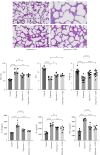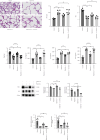Lactobacillus reuteri Alleviates Hyperoxia-Induced BPD by Activating IL-22/STAT3 Signaling Pathway in Neonatal Mice
- PMID: 39687635
- PMCID: PMC11649352
- DOI: 10.1155/mi/4965271
Lactobacillus reuteri Alleviates Hyperoxia-Induced BPD by Activating IL-22/STAT3 Signaling Pathway in Neonatal Mice
Abstract
Bronchopulmonary dysplasia (BPD) is the most common chronic respiratory disease in preterm infants. Little is known about the regulatory effect of lung Lactobacillus and its mechanism in BPD. This study explored the effect of L. reuteri on hyperoxia-induced mice lung injuries and examined whether L. reuteri played a role via the IL-22/STAT3 pathway. We found that the intranasal administration of L. reuteri and its tryptophan metabolite indole-3-aldehyde (3-IAld) ameliorated hyperoxia-induced mice lung BPD-like changes, deceased proinflammatory cytokines (IL-1β, IL-6, and TNF-α), and increased the levels of surfactant-associated protein C (SPC), aquaporin 5 (AQP5), and vascular endothelial growth factor receptor 2 (VEGFR2, also known as FLK-1). Furthermore, L. reuteri and 3-IAld increased the expression of IL-22. IL-22 was also confirmed to ameliorate hyperoxia-induced mice lung pathological changes, and the protective effects of L. reuteri could be inhibited by anti-IL-22 neutralizing antibody. Finally, we confirmed STAT3 activation by IL-22 in MLE-12 cells. In summary, our study confirmed L. reuteri alleviated hyperoxia-induced lung BPD-like changes in mice by activating the IL-22/STAT3 signaling pathway via IL-22 production. Probiotics Lactobacillus is a potential treatment for hyperoxia-induced lung injury in newborns.
Keywords: IL-22/STAT3 signaling pathway; L. reuteri; bronchopulmonary dysplasia; lung microbiota.
Copyright © 2024 Meiyu Zhang et al.
Conflict of interest statement
The authors declare no conflicts of interest.
Figures






Similar articles
-
Interleukin-11 Is Involved in Hyperoxia-induced Bronchopulmonary Dysplasia in Newborn Mice by Mediating Epithelium-Fibroblast Cross-talk.Inflammation. 2025 Apr;48(2):796-805. doi: 10.1007/s10753-024-02089-0. Epub 2024 Jul 24. Inflammation. 2025. PMID: 39046604
-
Recombinant CXCL17 Treatment Alleviates Hyperoxia-Induced Lung Apoptosis and Inflammation In Vivo and Vitro by Activating the AKT Pathway: A Possible Therapeutic Approach for Bronchopulmonary Dysplasia.Mol Biotechnol. 2024 Sep;66(9):2349-2361. doi: 10.1007/s12033-023-00866-0. Epub 2023 Sep 14. Mol Biotechnol. 2024. PMID: 37710083
-
Neutrophil extracellular traps promote bronchopulmonary dysplasia-like injury in neonatal mice via the WNT/β-catenin pathway.Front Cell Infect Microbiol. 2023 Apr 27;13:1126516. doi: 10.3389/fcimb.2023.1126516. eCollection 2023. Front Cell Infect Microbiol. 2023. PMID: 37180448 Free PMC article.
-
The Role of Sphingolipid Signaling in Oxidative Lung Injury and Pathogenesis of Bronchopulmonary Dysplasia.Int J Mol Sci. 2022 Jan 23;23(3):1254. doi: 10.3390/ijms23031254. Int J Mol Sci. 2022. PMID: 35163176 Free PMC article. Review.
-
Hyperoxia-induced bronchopulmonary dysplasia: better models for better therapies.Dis Model Mech. 2021 Feb 23;14(2):dmm047753. doi: 10.1242/dmm.047753. Dis Model Mech. 2021. PMID: 33729989 Free PMC article. Review.
References
-
- Speer C. P. Inflammation and Bronchopulmonary Dysplasia. Seminars in Neonatology . 2003;8(1):29–38. - PubMed
MeSH terms
Substances
LinkOut - more resources
Full Text Sources
Miscellaneous

